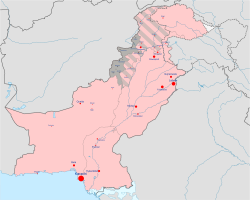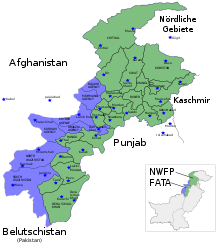Insurgency in Khyber Pakhtunkhwa
![]()
This article or section needs revision. More details should be given on the discussion page. Please help improve it, and then remove this tag.
Conflict in North-West Pakistan
Part of: War on Terror

Situation 2016Under
control of:
Government and allies
Taliban, al-Qaida and allies
The conflict in northwest Pakistan is an armed conflict between the Pakistan Army and Islamists, including the Tehrik-i-Taliban Pakistan (TTP). It began in 2004 when tensions escalated over the Pakistan Army's search for al-Qaeda members in Wasiristan.

Tribal Areas of Pakistan, including South and North Waziristan Chaibar Pachtunchwa (formerly North West Frontier Province, NWFP)
Previous story
After the Taliban regime in Afghanistan was overthrown by a US-led military operation in 2001, Taliban fugitives from Afghanistan established themselves in the northwestern regions of Pakistan. There they initially gained control of areas within the Federally Administered Tribal Areas (FATA), a Pakistani special territory inhabited by a majority of Pashtuns. This region, notably characterized by weak central government control, had previously been used by the Taliban as a retreat. From the tribal areas, the Taliban spread to the North West Frontier Province (NWFP) and Balochistan. From 2001 onwards, the then President Pervez Musharraf, in the context of the war on terror, tried to prevent the Taliban from establishing a foothold in northwestern Pakistan.
Outbreak of the conflict
At the beginning of 2004, the Pakistani central government sent 80,000 soldiers to the tribal areas. There, mainly in South and North Waziristan, there were clashes between Pakistani troops and the Taliban and other fighters, each joined by local clans. Several hundred Pakistani soldiers died in this conflict by 2006. Due to an initiative of the governor of the NWFP, Ali Muhammad Orakzai, a jirga was convened at this time, which was hoped to bring an end to the fighting. As a result of this meeting, the Pakistani government concluded the Miranshah Agreement with the tribes of North Waziristan on September 5, 2006. The key points were a withdrawal of the Pakistani army from the tribal areas and the cessation of hostilities by the Pakistani armed forces. Instead, tribesmen were to replace government troops and provide protection for the local authorities.
The Miranshah Agreement of 5 September 2006 ended the disputes between the Pakistani government and the majority of local tribes. However, it was criticised for encouraging rather than stopping Taliban influence. The Taliban subsequently assassinated several tribal leaders who had co-signed the agreement and continued their expansion. In 2007, the Taliban openly recruited new members in madrasas and attempted to force their cooperation by attacking school authorities. The Taliban also carried out attacks against establishments that were not compatible with their worldview, such as music and video stores and fashion shops. In addition, the Taliban targeted criminals as well as authorities. At this time, they increasingly took hostages among the region's police forces, thereby freeing imprisoned fellow fighters. In December 2007, the various Islamist and Taliban groups merged to form "Tehrik-i-Taliban Pakistan" (TTP), the Taliban movement in Pakistan. The leader of this organization became the Islamist and tribal leader Baitullah Mehsud. According to Harvard scholar Hassan Abbas, Mehsud's goals were to introduce Sharia law into Pakistan, to continue the fight against NATO in Afghanistan, and to wage a kind of "defensive jihad" against the Pakistani army and an uncompromising line against the Pakistani government. Abbas estimated that Mehsud had about 5,000 men under his command.
So far, the Pakistani military has been able to win almost every battle against the militants. However, militancy still remains strong in various parts of the North West Frontier Province. In 2008, Pakistan's military and the Frontier Corps received counterinsurgency training from Britain and the United States. When Mehsud died in a U.S. drone strike in early August 2009, violent clashes erupted over his succession, from which Hakimullah Mehsud emerged as the Taliban's new leader.
Search within the encyclopedia